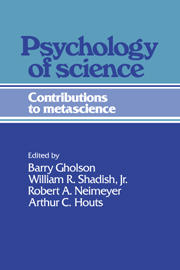Book contents
- Frontmatter
- Contents
- Preface
- Contributors
- 1 The psychology of science: An introduction
- Part I Historical issues in the psychology of science
- Part II The case for a psychology of science
- Part III Creativity and the psychology of science
- Part IV Cognition in the psychology of science
- 10 Cognitive paradigms and the psychology of science
- 11 Historical shifts in the use of analogy in science
- 12 Imagery, metaphor, and physical reality
- 13 A framework for the cognitive psychology of science
- Part V Social factors in the psychology of science
- Part VI Epilogue and Prologue
- Author index
- Subject index
11 - Historical shifts in the use of analogy in science
Published online by Cambridge University Press: 05 June 2012
- Frontmatter
- Contents
- Preface
- Contributors
- 1 The psychology of science: An introduction
- Part I Historical issues in the psychology of science
- Part II The case for a psychology of science
- Part III Creativity and the psychology of science
- Part IV Cognition in the psychology of science
- 10 Cognitive paradigms and the psychology of science
- 11 Historical shifts in the use of analogy in science
- 12 Imagery, metaphor, and physical reality
- 13 A framework for the cognitive psychology of science
- Part V Social factors in the psychology of science
- Part VI Epilogue and Prologue
- Author index
- Subject index
Summary
Analogy is widely considered to be an important mechanism of scientific thinking and a source of creative insight in theory development (e.g., Tweney, Chapter 13, this volume). No less an authority than Johannes Kepler stated: “And I cherish more than anything the Analogies, my most trustworthy masters. They know all the secrets of Nature, and they ought to be least neglected in Geometry” (quoted in Polya, 1954, p. 12). In addition to its uses in scientific discovery, analogy functions as part of the workaday tool kit of science. In instruction, novices are told to think of electricity as analogous to water or of addition as analogous to piling up blocks, and in problemsolving analogy is a standard tool among both experts and novices (e.g., see Clement, 1981; Collins & Gentner, 1987; Gentner & Gentner, 1983; Van Lehn & Brown, 1980). Finally analogy is also used in everyday reasoning, as when the stock market is said to “climb to dizzying heights” or when there is said to be a “balance of trade” (see Lakoff & Johnson, 1980).
Yet for all its usefulness, analogy is never formally taught to us. We seem to think of analogy as a natural human skill, and of the practice of analogy in science as a straightforward extension of its use in common-sense reasoning. For example, William James believed that “men, taken historically, reason by analogy long before they have learned to reason by abstract characters” (James, 1890, II, 363).
- Type
- Chapter
- Information
- Psychology of ScienceContributions to Metascience, pp. 296 - 325Publisher: Cambridge University PressPrint publication year: 1989
- 18
- Cited by



